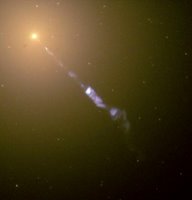Stellar birth control in the early universe
 | Extremely massive black holes in the centers of galaxies may serve as 'cosmic contraceptives' in the early Universe, suppressing the birth of new stars. |
New Haven, Conn. -- An international team of astronomers based at Yale and Leiden University in The Netherlands found that "old stars" dominated many large galaxies in the early universe, raising the new question of why these galaxies progressed into "adulthood" so early in the life of the universe.
Every year only a handful of new stars are born out of the gas that fills the space between the stars in galaxies like the Milky Way. To account for the large number of stars in the Universe today, about 400 billion in the Milky Way alone, it was thought that the "stellar birth rate" must have been much higher in the past.
Surprisingly, in this study appearing in the October 2 issue of Astrophysical Journal, astronomers using the 8.1m Gemini telescope in Chile report that many of the largest galaxies in the Universe had a very low stellar birth rate even when the Universe was only about 20 percent of its present age.
"Our new results imply that the stars in many large galaxies were born when the Universe was in its infancy, in the first few billion years after the Big Bang," said team leader Mariska Kriek, a PhD student from Leiden University and Yale. "The results confirm what some astronomers had suspected -- galaxies seem to have some method of 'birth control' that is very effective."
These new findings add to growing evidence that in big galaxies the formation of new stars was significantly suppressed after an initial period of vigorous activity. "These galaxies had a very violent early youth, but rose into stable adulthood well before many galaxies like the Milky Way were even in kindergarten," said Kriek."
The astronomers used the uniquely powerful Gemini Near Infrared Spectrograph, to analyze the light of distant galaxies simultaneously over many different wavelengths. They studied 20 galaxies so distant that their light had been traveling for nearly 11 billion years, or 80 percent of the age of the Universe.
"The unexpected finding is what was not found -- we expected to see a prominent signal from ionized Hydrogen, the tell-tale signature of star birth. Remarkably, for nine of the twenty galaxies that we observed, this signature is not seen at all," said Pieter van Dokkum, associate professor of astronomy and physics at Yale University. "It gives a firm limit on the stellar birth rate in these objects."
One suggestion is that enormous black holes in the centers of large galaxies may be responsible for suppressing star formation. When material spirals into a black hole, huge amounts of energy are released and are rapidly injected into the galaxy's gas. This energy injection may dilute the gas sufficiently to prevent future star birth.
"Evidence for the presence of these black holes is seen in several of the galaxies studied, lending support to the idea that black holes serve as cosmic contraceptives in the young Universe," said van Dokkum. ###
The research was funded by the Netherlands Foundation for Research, the Leids Kerkhoven-Bosscha Fonds, the National Science Foundation, and NASA. Other authors on the paper were Ryan Quadri, Eric Gawiser, David Herrera, Danilo Marchesini and C. Megan Urry from Yale; Marijn Franx, Edward N. Taylor and Stijn Wuyts from Leiden; Garth D. Illingworth, University of California, Santa Cruz; Ivo Labbe, Carnegie Observatories, Pasadena, CA; Paulina Lira, Universidad de Chile; Hans-Walter Rix, Max-Planck-Institute fur Astronomie; Gregory Rudnick, National Optical Astronomy Observatory, Tucson, AZ and Sune Toft, European Southern Observatory, Munchen, Germany.
Citation: Astrophysical Journal: (October 1, 2006
Contact: Janet Rettig Emanuel janet.emanuel@yale.edu 203-432-2157 Yale University
Technorati Tags: ASTRONOMICAL or GALAXY and Big Bang or stellar evolution and Astrophysics or supernova and black+hole or astronomers and neutron star or black holes and Milky Way galaxy or universe and deuterium or galaxy M87
RELATED: Keyword, Supernova, Sunday, August 20, 2006 observations shake up galactic formation theories, Sunday, July 09, 2006 Supernova leaves behind mysterious object, Sunday, June 11, 2006 Massive-star supernovae found to be major space dust factories, Sunday, April 23, 2006 DEADLY ASTRONOMICAL EVENT NOT LIKELY TO HAPPEN IN OUR GALAXY,











No comments:
Post a Comment